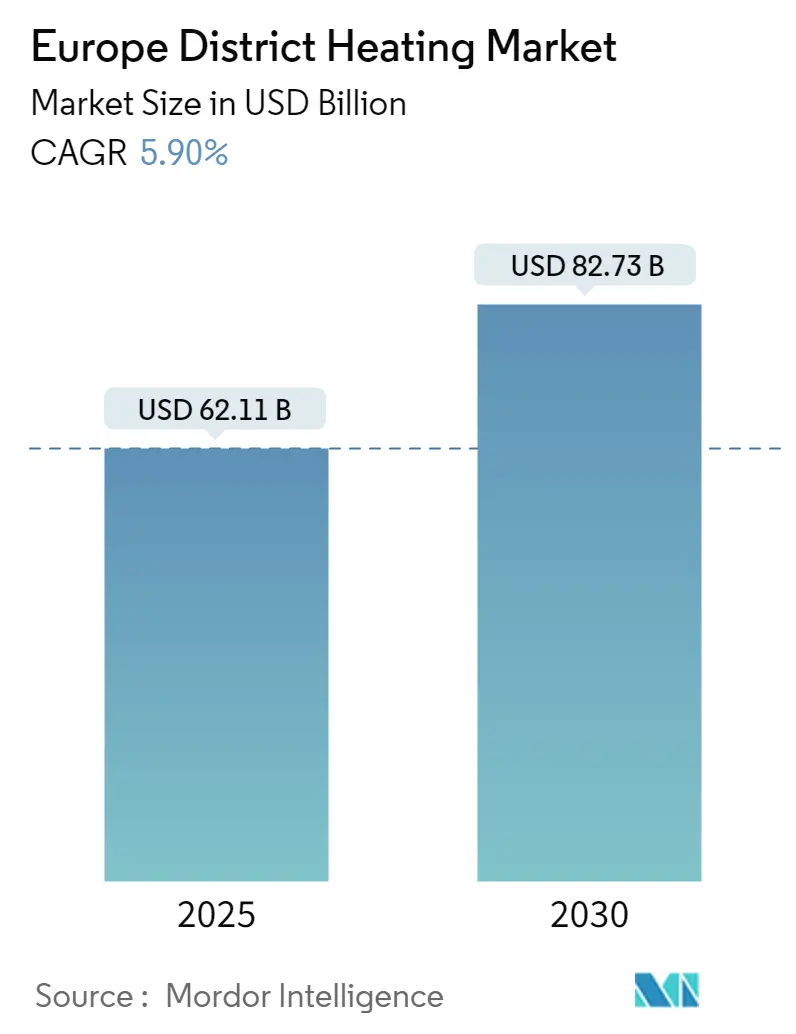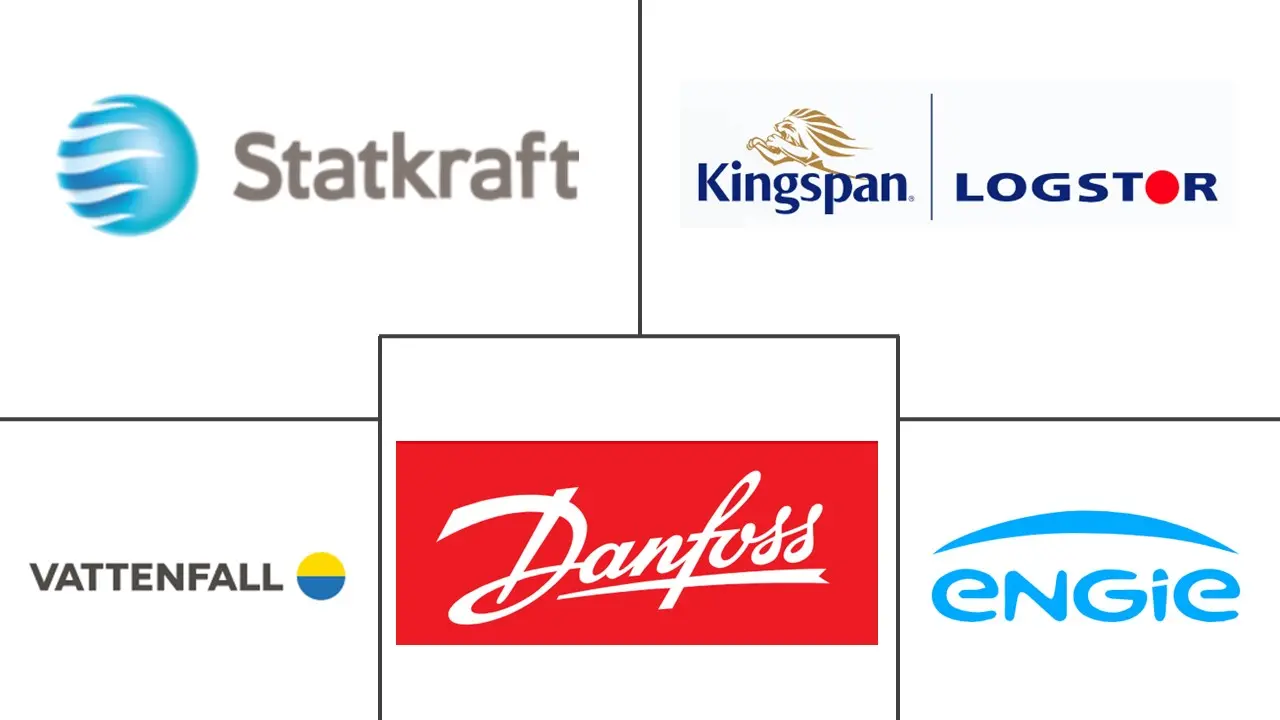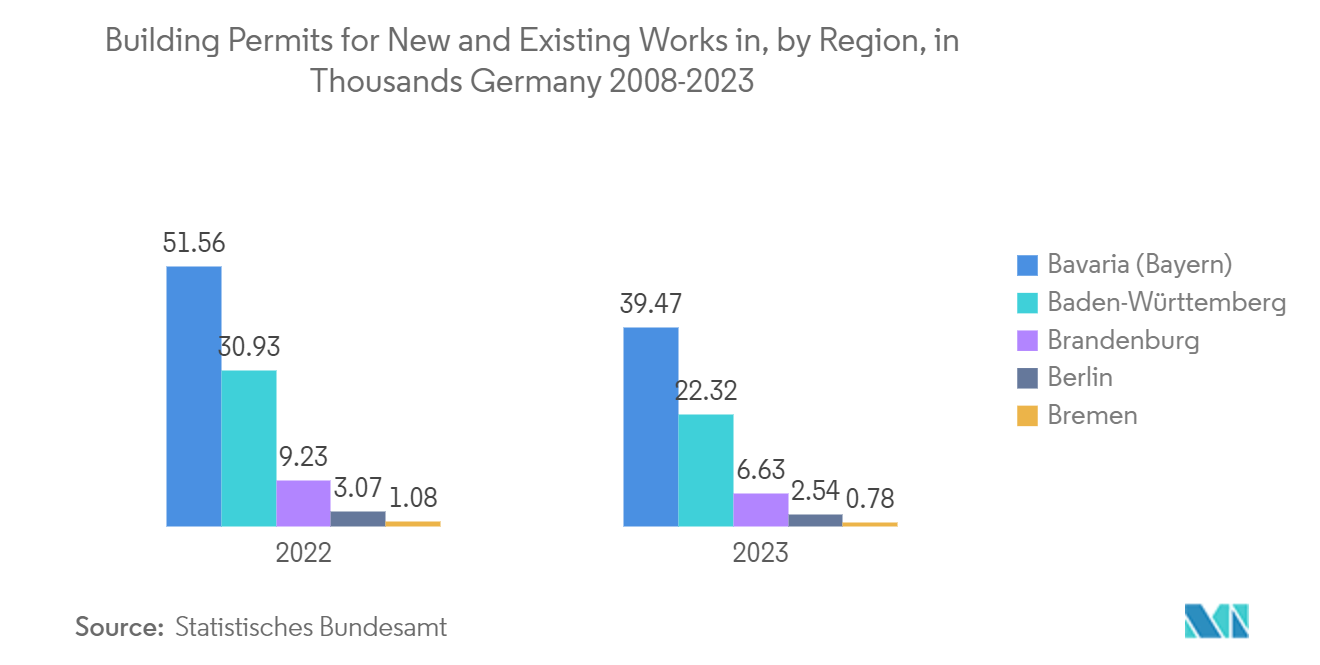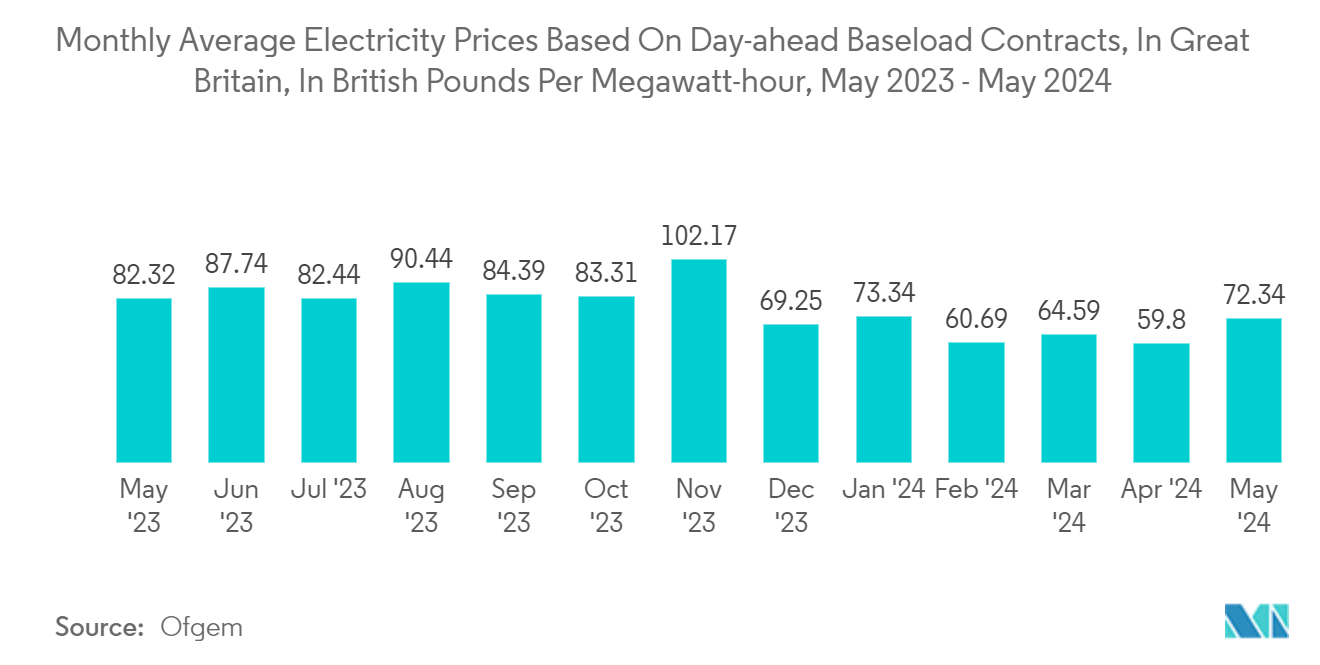
| Study Period | 2019 - 2030 |
| Base Year For Estimation | 2024 |
| Forecast Data Period | 2025 - 2030 |
| Market Size (2025) | USD 62.11 Billion |
| Market Size (2030) | USD 82.73 Billion |
| CAGR (2025 - 2030) | 5.90 % |
| Market Concentration | Medium |
Major Players
*Disclaimer: Major Players sorted in no particular order |
Europe District Heating Market Analysis
The Europe District Heating Market size is estimated at USD 62.11 billion in 2025, and is expected to reach USD 82.73 billion by 2030, at a CAGR of 5.9% during the forecast period (2025-2030).
Introducing new technologies like machine learning, IoT services, and smart meters has helped optimize the heating cycles according to the varying demands in Europe.
- A district heating system helps achieve energy efficiency and reduces the cost for both residential and commercial users. The demand for the solutions is expected to be particularly high in Europe. It is expected to see higher investments over the coming years. According to the Heat Roadmap Europe data, if the urbanization trend continues and appropriate investments are implemented, district heating could meet almost half of Europe's heat demand by 2050.
- Approximately 60 million EU (European Union) citizens are currently served by district heating, with an additional 140 million people living in cities with at least one district heating system. According to EU and the IEA reports, DH currently meets around 11-12 percent of the EU's heat demand via 6,000 district heating and cooling networks.
- The increasing focus on the shift toward renewable energy sources, instead of fossil fuels, by the governments of multiple countries across the globe is expected to offer great opportunities for innovations in the district heating market. For instance, in February 2022, the European heating market agreed to phase out fossil gas, a joint decision undertaken by NGOs and industry.
- For instance, Finland plans to increase the renewable energy share in its energy consumption to about 50 percent by 2030. Further, a medium-term climate change plan for 2030 was released. Finland plans to close coal-fired CHP plants slowly by 2030, along with financially supporting operators that switch to efficient biomass CHP and new heating technologies by 2025. It is expected to decrease the district heating CHP capacity due to the decommissioning of plants. The remaining district heating CHP plants can be converted to 100 percent biomass.
- Additionally, the increasing decarbonization initiatives across the globe, specifically in Europe, led to initiatives and programs that fuel the transition of district heating systems from fossil fuels to renewables. Moreover, Vattenfall AB has plans to decarbonize its production portfolio in the cities. The decarbonization process is expected to be implemented first, with the coal/peat phase-out by 2030, followed by the replacement of fossil gas by 2050.
- However, the installation of district heating systems often requires significant initial investment costs. This cost factor can act as a restraint on the market growth. The district heating systems may also need help in providing efficient heating solutions for small heating loads or in areas with limited space for distribution grids.
- Moreover, Russia's invasion of Ukraine has highly impacted energy and food markets across the globe, especially in Europe. Since the second half of 2021, there has been a sharp increase in energy prices in the region. The price of fuels has risen as a consequence of the Russia-Ukraine war, which has also led to concerns related to the security of the energy supply in the region. Russia's decision to suspend gas deliveries to several EU member states has further impacted the situation.
Europe District Heating Market Trends
Residential End User Segment is Expected to Hold Significant Market Share
- The residential consumption from the district heat systems accounts for a major share in Europe. This leads to many carbon emissions, hampering the countries' zero-emission goals of 2050. Hence, governments are actively forming regulations to manage district heat among residents efficiently. Several companies are innovating efficient solutions to cope with the pressing energy problems and increasing carbon emissions in Europe. For instance, in February 2022, a hydrogen heating trial began in Wales to test the 'world’s first hydrogen hybrid heating system.
- Further, the UK Government is presently offering contributions to the initial capital outlay on heat pumps, with GBP 5,000 (~USD 6,110) of the cost and installation of an air source heat pump and GBP 6,000 (~USD 7,332) for ground source heat pumps. However, the initial installation costs of an electric heat pump are still an off-putting hurdle to many potential users in the country.
- According to the European Commission, Buildings account for 40 percent of Europe's energy consumption. Various functions like cooling, heating, and domestic hot water form 80 percent of the energy consumed by the citizens. This indicates the total energy requirement for district heating systems for households and buildings, demanding better energy management. Hence, the European region is open to companies developing greener solutions for space heating and other district heating-related services.
- The European Commission also indicates that more than 30 million building units consume excessive energy. This excess consumption accounts for nearly 2.5 times more than average buildings, which drives up households' energy bills. It highlights the high energy requirements for families in Europe, but it also makes room for energy-efficient district heating solutions. Companies are introducing individual heating solutions using renewable energy resources.
- As the electricity prices hike, households rely on natural gas to fuel their heating systems daily. Natural gas is another fossil fuel that can be preserved and put to better use. Introducing heating systems fueled by renewable energy resources like solar energy, geothermal energy, and others will help manage the energy expenses effectively and contribute actively to reducing the CO2 emission footprint for 2050 environmental goals in Europe.

Germany is anticipated to Drive the Market Growth in Europe
- According to the Federal Statistical Office (Germany), in 2022, the population in Germany, as of December 31 of that year, amounted to 84.36 million people, an increase from 83.24 million in 2021. The average annual temperature in Germany, reported by climate-data.org, is about 8.7 degrees Celsius. These demographics show Germany's primarily cold and densely populated demography, making it a perfect region for district heating facilities.
- The overall prices for energy consumption are higher in Germany compared to other regions. For instance, according to globalpetrolprices.com, the electricity prices in Germany in September 2022 accounted for USD 0.620 USD per kWh for households and 0.918 USD for businesses, compared to the world average electricity prices of USD 0.335/kWh for households and USD 0.261/kWh for businesses. This clearly states how the demand for alternative hot water and heating solutions for buildings becomes necessary to tackle the high electricity prices. Hence, Germany is a promising district heating solutions and heat pumps market.
- Several Government regulations promote the adoption of renewable energy resources in the district heating sector, encouraging the companies to use advanced technologies. The German government takes serious and long-term steps under the Climate Action Plan 2050. For instance, according to BMUV (Federal Ministry for the Environment, Nature Conservation, Nuclear Safety, and Consumer Protection), the Climate Action Plan aims to reduce CO2 emissions by 66-67 percent by 2030 compared to the emissions in 1990, to achieve virtually climate-neutral heat by 2050 across Germany. Such dedicated measures pave the way for companies looking forward to introducing greener district heating solutions in the country.
- In German private households, district heating is used for the most part for space heating. Heating consumption in the industry tends to be more dependent on economic developments; manufacturing businesses tend to use district heating and cooling instead of industrial processes. In the commerce/trade/services sector, in addition to using space heating, use for heating water and other heating and cooling processes also plays a role.
- In Germany, district heating and cooling are considered a particularly important instrument in reducing primary energy consumption and improving Germany's security of supply. According to the district heating association AGFW, until 2030, the combined use of district heating and combined heat and power production could reduce primary energy consumption by 4 percent and national energy imports by 15 percent.

Europe District Heating Industry Overview
The European district heating market is Semiconsloidated, with the presence of major players like Vattenfall AB, Danfoss AS, Engie SA, Statkraft AS, and Logstor AS. Players in the market are adopting strategies such as partnerships and acquisitions to enhance their product offerings and gain sustainable competitive advantage.
In September 2022, The German government announced the EUR 3 billion (USD 3.20 billion) subsidy scheme until 2026 that would sustain the construction of district heating grids that use at least 75 percent renewable energy.
In April 2023, TU Dublin, in collaboration with South Dublin County Council (SDCC) with the assistance of the Dublin energy agency, Codema, announced that it would be part of Ireland's first low-carbon sourced district heating system, with its Tallaght campus part of an innovative, low-carbon initiative. The not-for-profit Heatworks district heating network will initially provide heat to 32,800 sq mts of local public buildings at TU Dublin and SDCC, expanding to heat 133 affordable apartments in 2025.
Europe District Heating Market Leaders
-
Vattenfall AB
-
Danfoss A/S
-
Energie SA
-
Statkraft AS
-
LOGSTOR Denmark Holding ApS
- *Disclaimer: Major Players sorted in no particular order
.webp)
Europe District Heating Market News
- July 2024: The World Bank has introduced a substantial USD 3.86 billion initiative, known as the “Scaling Up Energy Efficiency in Europe and Central Asia Program” (E3 Program), aimed at significantly enhancing energy efficiency in the region. Over its ambitious 10-year duration, the program seeks to save more than 63 terawatt hours (TWh) of energy—equivalent to Switzerland’s annual electricity production—and reduce CO2 emissions by 18.7 million metric tons. The program's initial projects will concentrate on improving energy efficiency in public facilities, residential buildings, industrial sectors, and district heating systems across the participating countries.
- April 2024: The European Commission has established a public-private partnership to enhance investments in energy efficiency projects, aiming to support the EU's emission reduction objectives. Furthermore, the directive requires EU member states to convert their district heating and cooling systems to fully utilize renewable energy, waste heat, or a combination of both by 2050.
Europe District Heating Industry Segmentation
District heating provides heat to households and commercial buildings by supplying hot water through a distributive channel of insulated pipes. The resources used for heating are shifting from fossil fuels like coal and natural gas to renewable sources of energy like solar energy and geothermal energy.
The Europe district heating market is segmented by end-user (residential, commercial, and industrial) and country (Germany, France, Poland, Scandinavian Countries, Czech Republic, Austria, and the Rest of Europe). The market sizes and forecasts are provided in terms of USD value for all the above segments. The study also examines the impact of macroeconomic trends on the market and impacted segments. The study also discusses the drivers and restraints likely to influence the market's evolution in the near future. The market sizes and forecasts are provided in terms of value (USD) for all the above segments.
| By End User | Residential |
| Commercial and Industrial | |
| By Country | Germany |
| France | |
| Poland | |
| Czech Republic | |
| Austria |
Europe District Heating Market Research Faqs
How big is the Europe District Heating Market?
The Europe District Heating Market size is expected to reach USD 62.11 billion in 2025 and grow at a CAGR of 5.90% to reach USD 82.73 billion by 2030.
What is the current Europe District Heating Market size?
In 2025, the Europe District Heating Market size is expected to reach USD 62.11 billion.
Who are the key players in Europe District Heating Market?
Vattenfall AB, Danfoss A/S, Energie SA, Statkraft AS and LOGSTOR Denmark Holding ApS are the major companies operating in the Europe District Heating Market.
What years does this Europe District Heating Market cover, and what was the market size in 2024?
In 2024, the Europe District Heating Market size was estimated at USD 58.45 billion. The report covers the Europe District Heating Market historical market size for years: 2019, 2020, 2021, 2022, 2023 and 2024. The report also forecasts the Europe District Heating Market size for years: 2025, 2026, 2027, 2028, 2029 and 2030.
Our Best Selling Reports
Europe District Heating Industry Report
Statistics for the 2025 Europe District Heating market share, size and revenue growth rate, created by Mordor Intelligence™ Industry Reports. Europe District Heating analysis includes a market forecast outlook for 2025 to 2030 and historical overview. Get a sample of this industry analysis as a free report PDF download.




